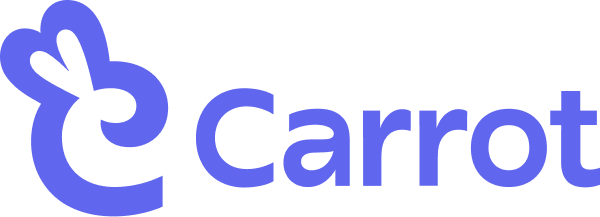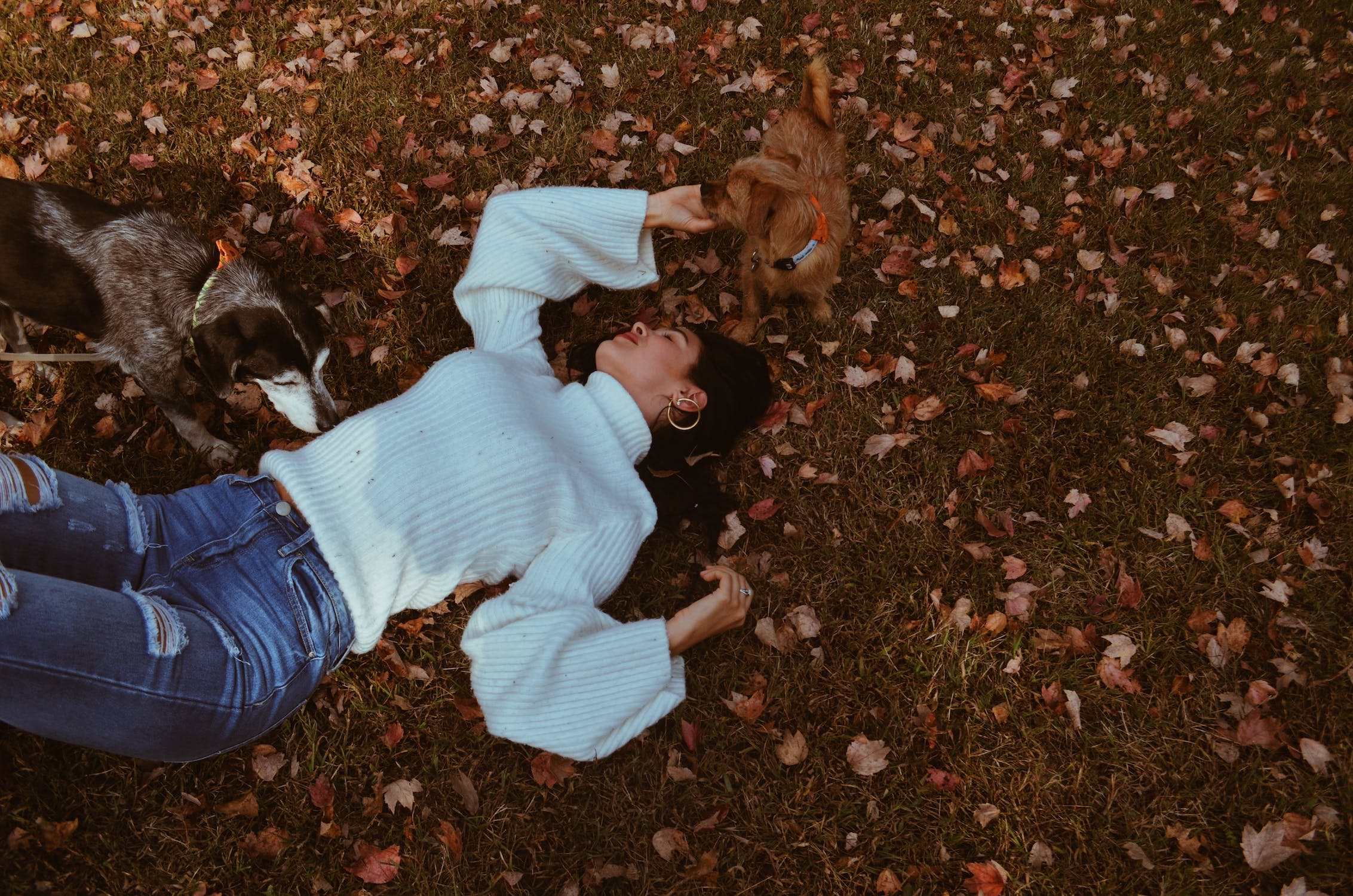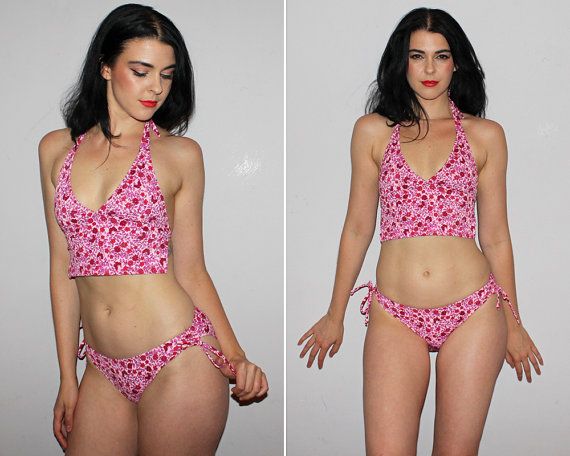New + updated
The 12 Best Snowboard Brands of 2024
March 4th
When we think of a swimsuit today, the first thing that pops into most of our heads is a bikini. No one bats an eye when we see someone wearing one, because it’s just a normal occurrence. But did you know that women had to stay covered from head to toe for decades, even when swimming? Bikinis might feel pretty surreal to them if they paid us a little visit from the past. Swimsuit history is fascinating (and honestly, a bit sad), y’all.
From fully covered, woolen bathing suits in the 1800s, how, exactly, did we end up with two-piece, barely-there bikinis in the 2000s? Let’s break it down!
Medieval “Swimwear”
To understand swimsuit history, we’ll have to go all the way back to Ancient Rome when there was no formal concept of swimming for pleasure. When they did swim or bathe, however, they either did so in their private baths or common bathing rooms, separate for men and women.

A bathhouse was basically just a big room with a huge pool/bathtub in the center where multiple people could bathe at once. And since you were technically just bathing in private or with your own gender, there wasn’t a need to cover yourself up.
So your medieval swimwear was just your birthday suit. This was the case for many, many more years. Men and women simply bathed separately, whether it was in private or in groups of their own gender. In fact, during the Middle Ages, swimming was actually considered indecent – and this mindset carried itself into the 18th century.
18th Century Swimsuit History
If you saw a “swimsuit” from the 18th century today, you wouldn’t think it was one. In fact, it wasn’t even called a swimsuit. They used to call it a “bathing gown”. Because it was literally a gown.
These gowns used to be made of either flannel, canvas, or wool (talk about bizarre fabric choice). While they weren’t exactly floor-length, these were so long that they’d float away from the body once inside the water.
And, to cover up the rest of the skin that showed below the dress, many women even had to wear long socks before they went out in public.
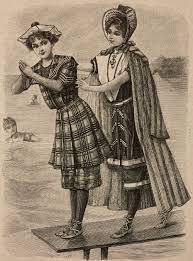


Men continued to swim “freely” well into the 1700s, as restrictions for women stayed in place. In fact, there also came a time when they started adding weights to the hems of the bathing gowns. This prevented the gown from floating up once the woman got into the water.
There was also something called a “bathing machine” that mostly women used around this time. A big, portable box with wheels would be rolled into or close to the water so that they could step in and change into their bathing gowns.
We bet no woman actually enjoyed swimming with all that hassle.
Bathing Suits in the 1800s (19th Century)
Thankfully, swimsuit history kept evolving with time, and women didn’t have to endure the woolen gowns for too long (just a century or so). Not that they were much better than their predecessor, but the “bloomer swimsuits” were cut slightly higher up than the bathing gowns and included pants!
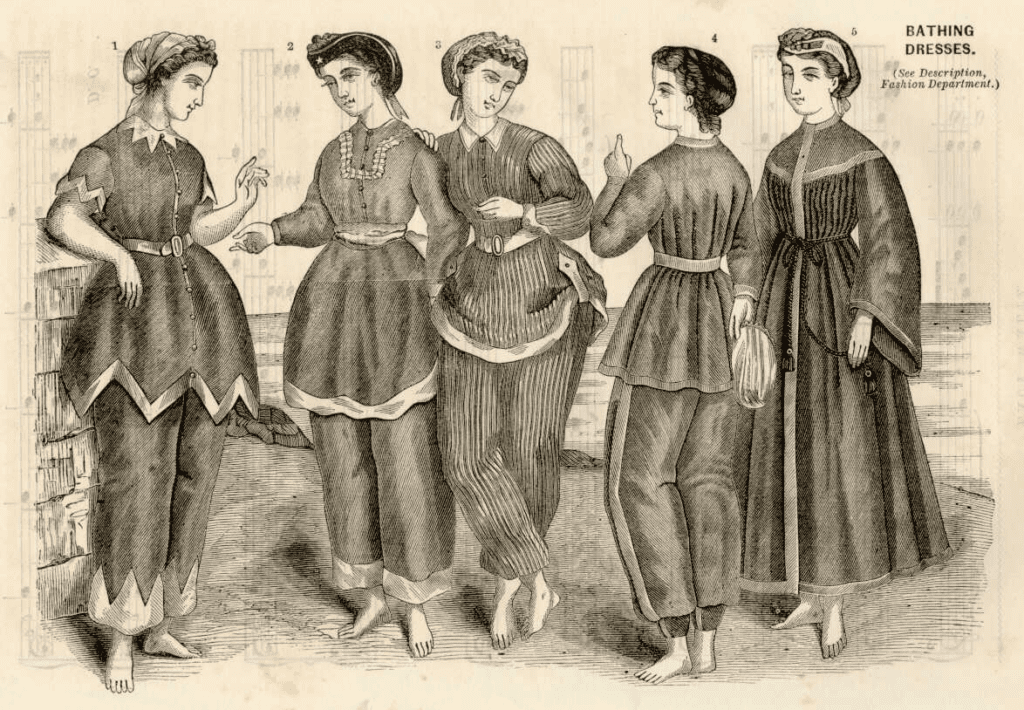


And since pants were only supposed to be worn by men at the time, it was kind of controversial for women to do so.
But of course, remaining covered was still the priority, which is why these outfits were also full-length— patriarchy with a dash of swimsuit history.
Around this time, women also started wearing “bathing slippers” and hats matching their swimsuits. The slippers were more for practical than fashion purposes – to protect their feet from shells and broken glass. However, they still used to decorate them using ribbons and bows. Bathing caps were also worn to protect their hairstyles, which, at the time used to take hours to do.
The bloomers were used till the mid-20th century, with slight modifications over the years. That was until the concept of swimming started emerging as a serious sporting activity.
A Woman Wears A Men’s Swimsuit (And Gets Arrested)?!
In the early 20th century, as swimming began to be recognized as a sport, Australian actress and swimmer Annette Kellerman wore a form-fitting one-piece suit that was typically only seen on men.
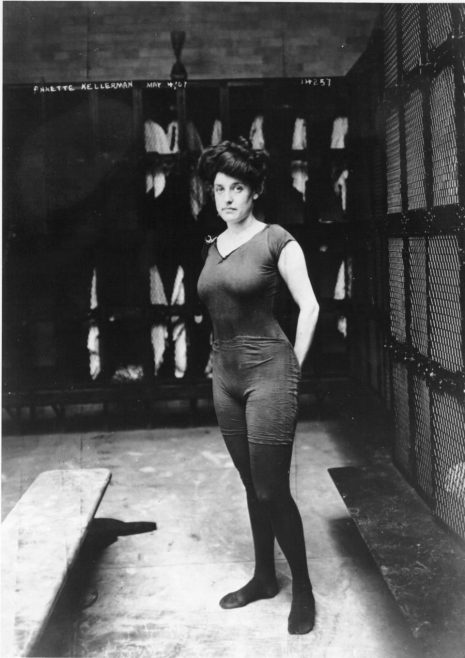


Kellerman wore this suit for her competition in Boston in 1907. She needed this kind of fit for the speed that was required by her to win.
However, she was arrested for public indecency when she wore it on a beach. But this didn’t stop other women from following suit. Annette’s move actually paved the way for one-piece swimsuits for women.
In fact, they started decorating the suits with frills and other things (even pockets!). The lengths were altered, and swimsuits were now being seen as a fashion statement. The actual evolution of swimsuit history is just beginning!
20th Century Swimsuit History Evolves
The 1920s swimsuits noticed a drastic change from Kellerman’s full-length suit to something much shorter and form-fitting. Finally given the rightful term “swimming suits” by swimwear manufacturer Jantzen, they were composed of shorts and a long tank top. However, they still had to be a certain length, or you could get arrested or fined.
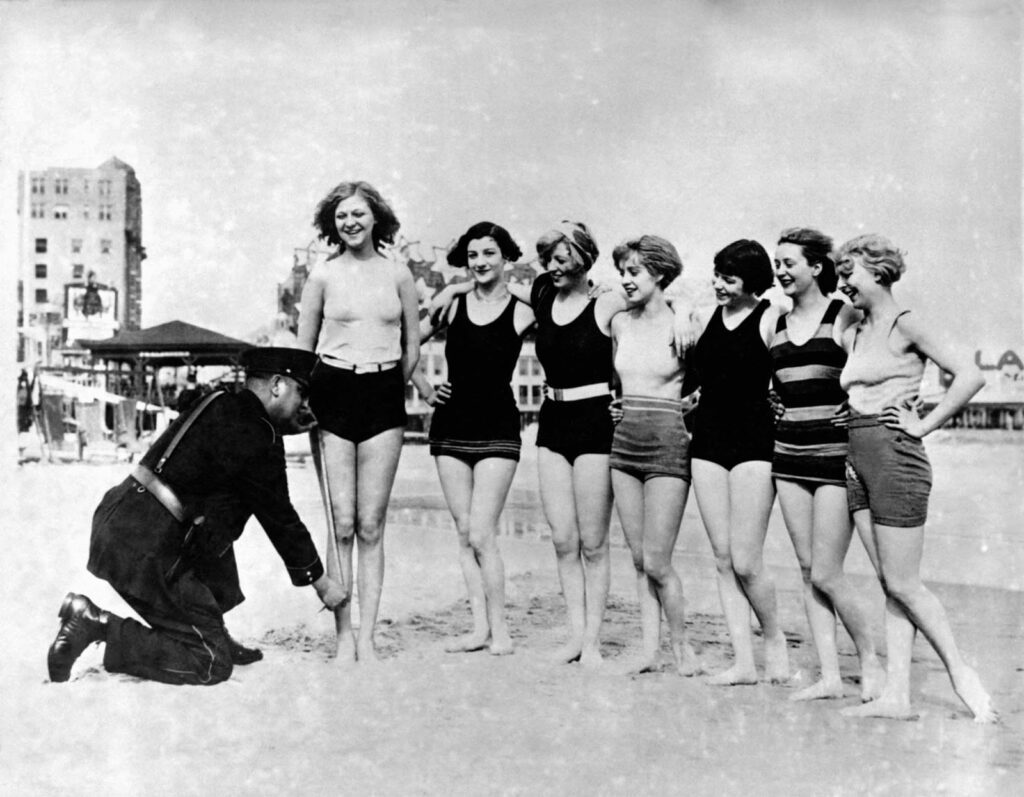


The situation was actually so weird that cops used to roam the beaches with a ruler or an inch-tape so they could measure the length of your swimsuit. Degrading much?



Men’s swimsuits around this time were typically one-pieces with a tee or tank top and shorts. The most common (basically the only) design found here were thick horizontal stripes which came in red and blue.
Swimsuit history in the 1930s finally saw the potential in one-piece swimsuits for women, as major sporting events like the Olympics began recognizing swimming as an actual competitive sport.
These suits reflected a similar design to the men’s suit with lower necklines and higher hemlines. The tanks also had thinner straps. The overall suit started to be made from a thinner, rubber-like material which provided ease of movement.
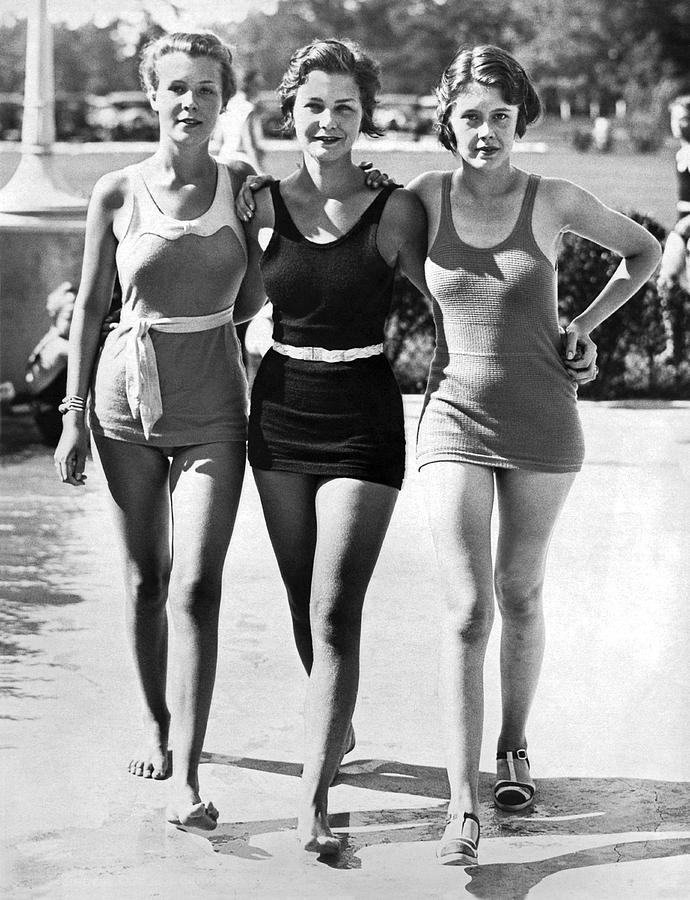


The Bikini Arrives – Finally!
The 1940s is when the evolution of the bikini really begins. One-pieces began seeing more and more modifications into dresses as well as modest two-pieces. Around this time, French engineer Louis Réard introduced the first-ever bikini.
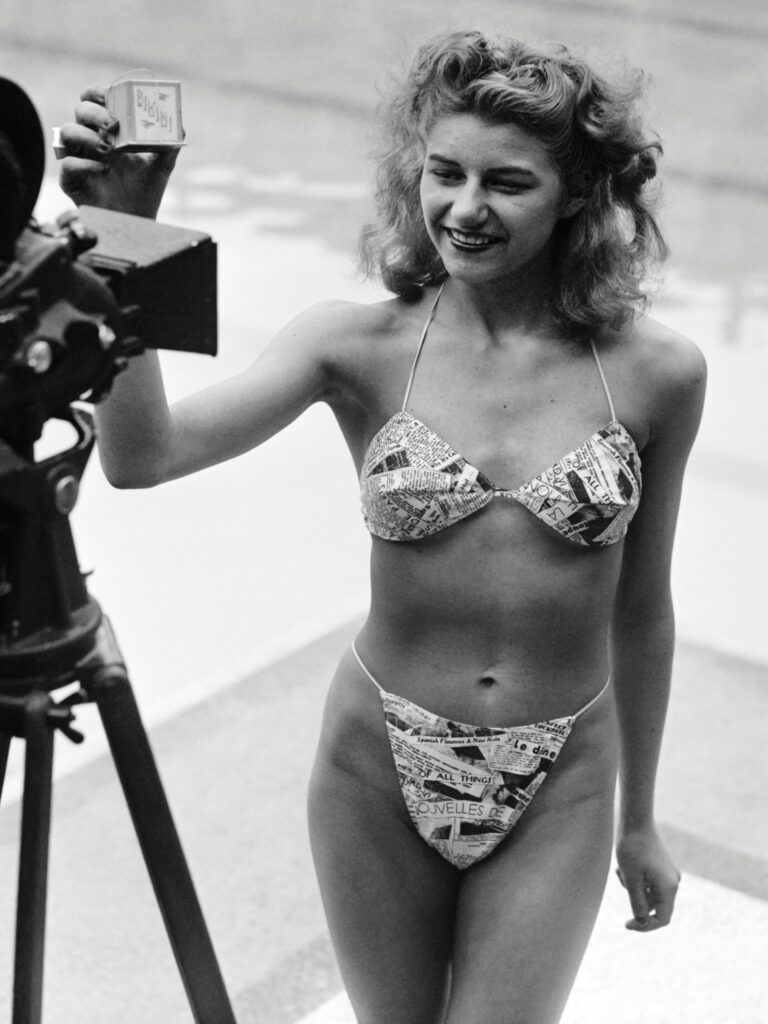


Named after Bikini Atoll Islands, this risqué piece was designed to be just as explosive as the nuclear tests that took place there.
It was worn for the first time in public in 1946 by French model Micheline Bernardini. Around the time of the Second World War, lesser clothing was preferred more in America. Rationing during the war meant fewer materials, which paved the way for more revealing clothing.
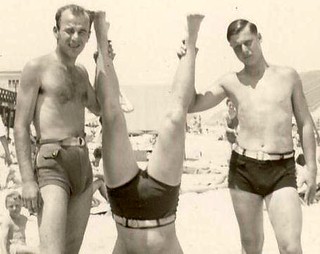


Swimming briefs made of rayon-Spandex blend became a go-to for men around this time. Besides that, the newly introduced swim trunks were also gaining popularity.
The trunks were longer and looser than briefs, giving them room to breathe.
As the decades evolved, so did swimsuit history. Bikinis became even more daring and one-pieces kept plunging their necklines. These swimsuits also saw multiple innovations in design, color, and pattern throughout this time.
While we did see many innovations since the introduction of the pioneer bikini, they weren’t many notable differences from the ones we see or wear today. In the late 90s and early 2000s, however, the tankini (above) was introduced by designer Anne Cole.
As the years progressed after that, swimsuit history saw the usage of a mix of all kinds of swimsuits – from the traditional one-piece to every version of the bikini. At the same time, men’s swimwear mostly remained the same after the introduction of trunks.
Didn’t we tell you swimsuit history was fascinating?
🥕 Did this piece make you want to browse cute swimsuits online? Carrot can help! Add to cart and save all your finds in one single place. Get your bestie’s opinion on the coolest bikinis by simply sharing a link to your collection. Track prices, compare and even get notified when there’s a price drop. The best part — Carrot is freeee!
